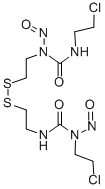N-NITROSO-N-ETHYLUREA
Synonym(s):ENU;N-Ethyl-N-nitrosourea
- CAS NO.:759-73-9
- Empirical Formula: C3H7N3O2
- Molecular Weight: 117.11
- MDL number: MFCD00053635
- EINECS: 212-072-2
- SAFETY DATA SHEET (SDS)
- Update Date: 2024-12-18 14:15:32

What is N-NITROSO-N-ETHYLUREA?
Chemical properties
Orange Paste
Chemical properties
N-Nitroso-N-ethyl urea is a pale yellow, crystalline powder; freezing/melting point=103-104°C (decomposes). Hazard identification (based on NFPA-704 M Rating System): Health 2; flammability 1; reactivity 0?. Soluble in water; hydrolysis produces explosive gas.
The Uses of N-NITROSO-N-ETHYLUREA
A precursor of Diazoethane
The Uses of N-NITROSO-N-ETHYLUREA
Experimentally as mutagen; ethylating agent.
The Uses of N-NITROSO-N-ETHYLUREA
N-Nitroso-N-ethylurea has been used as a mutation-inducing agent.
What are the applications of Application
N-Nitroso-N-ethylurea is a precursor of Diazoethane
Definition
ChEBI: A member of the class of N-nitrosoureas that is urea in which one of the nitrogens is substituted by ethyl and nitroso groups.
General Description
Yellow-pink crystals or off-white powder. Sensitive to light.
Air & Water Reactions
Water soluble. Sensitive to moisture--stability in aqueous solutions depends on pH.
Reactivity Profile
N-NITROSO-N-ETHYLUREA is highly reactive. Sensitive to moisture and light. Its stability in aqueous solutions is pH-dependent. Incompatible with water and nucleophilic reagents. Alkaline hydrolysis produces a highly explosive gas. .
Hazard
Tumorigen, carcinogen, neoplastigen; teratogen; poison; toxic.
Health Hazard
ACUTE/CHRONIC HAZARDS: N-NITROSO-N-ETHYLUREA is extremely unstable at high pH. It will decompose to extremely unstable decomposition products if acidic conditions are not maintained. When heated to decomposition it emits toxic fumes of nitrogen oxides. Decomposition products may be explosive.
Fire Hazard
Flash point data for N-NITROSO-N-ETHYLUREA are not available; however, N-NITROSO-N-ETHYLUREA is probably combustible.
Biochem/physiol Actions
DNA alkylating agent that is carcinogenic in many animal species. Induces benign and malignant tumors of numerous types, including the nervous tissue, stomach, esophagus, pancreas, respiratory tract, intestine, lymphoreticular tissues, skin, and kidney.
Safety Profile
Confirmed carcinogen with experimental carcinogenic, neoplastigenic, tumorigenic, and teratogenic data. Poison by ingestion, subcutaneous, intraperitoneal, and intravenous routes. Human mutation data reported. When heated to decomposition it emits toxic fumes of NOx. See also N-NITROSO COMPOUNDS.
Potential Exposure
Used as a chemical intermediate for dyes and pharmaceuticals; a polymerization inhibitor during the manufacture of vinyl monomers such as styrene; a precursor of diazoethane; accelerator for rubber vulcanization.
Carcinogenicity
N-Nitroso-N-ethylurea is reasonably anticipated to be a human carcinogen based on sufficient evidence of carcinogenicity from studies in experimental animals.
Shipping
Toxic solids, organic, n.o.s., Hazard Class: 6.1; Labels: 6.1-Poisonous materials, Technical Name Required. UN3077 Environmentally hazardous substances, solid, n.o.s., Hazard Class: 9; Labels: 9-Miscellaneous hazardous material, Technical Name Required.
Incompatibilities
N-nitroso-N-ethylurea is highly reactive. Sensitive to moisture and light. Its stability in aqueous solutions is pH-dependent. Incompatible with water and nucleophilic reagents. Alkaline hydrolysis produces a highly explosive gas. This compound is extremely unstable at high pH. It will decompose to extremely unstable decomposition products if acidic conditions are not maintained. Nitrated organics range from slight to strong oxidizing agents. If mixed with reducing agents, including hydrides, sulfides and nitrides, they may begin a vigorous reaction. Reaction with
Waste Disposal
Consult with environmental regulatory agencies for guidance on acceptable disposal practices. Generators of waste containing this contaminant (≥100 kg/mo) must conform with EPA regulations governing storage, transportation, treatment, and waste disposal.
Properties of N-NITROSO-N-ETHYLUREA
| Melting point: | 103-1040C (dec) |
| Boiling point: | 182℃ |
| Density | 1.35 |
| refractive index | 1.4900 (estimate) |
| Flash point: | 64℃ |
| storage temp. | -20°C |
| solubility | DMSO (Soluble), Methanol (Sparingly) |
| pka | 12.32±0.50(Predicted) |
| form | Semi-Solid to Low-Melting Solid |
| color | Off-White to Red |
| Water Solubility | 12.83g/L(room temperature) |
| Stability: | Unstable at RT, Contains approximately 40% Water, 2.0% Acetic Acid to stabilize |
| CAS DataBase Reference | 759-73-9(CAS DataBase Reference) |
| IARC | 2A (Vol. 17, Sup 7) 1987 |
| EPA Substance Registry System | N-Nitroso-N-ethylurea (759-73-9) |
Safety information for N-NITROSO-N-ETHYLUREA
| Signal word | Danger |
| Pictogram(s) |
 Skull and Crossbones Acute Toxicity GHS06  Health Hazard GHS08 |
| GHS Hazard Statements |
H301:Acute toxicity,oral H350:Carcinogenicity H360:Reproductive toxicity |
| Precautionary Statement Codes |
P201:Obtain special instructions before use. P202:Do not handle until all safety precautions have been read and understood. P280:Wear protective gloves/protective clothing/eye protection/face protection. P301+P310:IF SWALLOWED: Immediately call a POISON CENTER or doctor/physician. |
Computed Descriptors for N-NITROSO-N-ETHYLUREA
New Products
4-Fluorophenylacetic acid 4-Methylphenylacetic acid N-Boc-D-alaninol N-BOC-D/L-ALANINOL Tert-butyl bis(2-chloroethyl)carbamate 3-Morpholino-1-(4-nitrophenyl)-5,6-dihydropyridin- 2(1H)-one Furan-2,5-Dicarboxylic Acid Tropic acid S-2-CHLORO PROPIONIC ACID ETHYL ISOCYANOACETATE 2-Bromo-1,3-Bis(Dimethylamino)Trimethinium Hexafluorophosphate (6-METHYL-[1,3]DITHIOLO[4,5-b]QUINOXALIN-2-ONE INDAZOLE-3-CARBOXYLIC ACID 4-IODO BENZOIC ACID (2-Hydroxyphenyl)acetonitrile 4-Bromopyrazole 5,6-Dimethoxyindanone 2-(Cyanocyclohexyl)acetic acid 4-methoxy-3,5-dinitropyridine 2-aminopropyl benzoate hydrochloride 1-(4-(aminomethyl)benzyl)urea hydrochloride diethyl 2-(2-((tertbutoxycarbonyl)amino) ethyl)malonate tert-butyl 4- (ureidomethyl)benzylcarbamate Ethyl-2-chloro((4-methoxyphenyl)hydrazono)acetateRelated products of tetrahydrofuran








You may like
-
 N-Nitroso-N-ethylurea CAS 759-73-9View Details
N-Nitroso-N-ethylurea CAS 759-73-9View Details
759-73-9 -
 HER2 (676-end), active, GST tagged human CASView Details
HER2 (676-end), active, GST tagged human CASView Details -
 N-Nitroso-N-ethylurea CAS 759-73-9View Details
N-Nitroso-N-ethylurea CAS 759-73-9View Details
759-73-9 -
 1975-50-4 98%View Details
1975-50-4 98%View Details
1975-50-4 -
 2-HYDROXY BENZYL ALCOHOL 98%View Details
2-HYDROXY BENZYL ALCOHOL 98%View Details
90-01-7 -
 2-Chloro-1,3-Bis(Dimethylamino)Trimethinium Hexafluorophosphate 221615-75-4 98%View Details
2-Chloro-1,3-Bis(Dimethylamino)Trimethinium Hexafluorophosphate 221615-75-4 98%View Details
221615-75-4 -
 14714-50-2 (2-Hydroxyphenyl)acetonitrile 98+View Details
14714-50-2 (2-Hydroxyphenyl)acetonitrile 98+View Details
14714-50-2 -
 118753-70-1 98+View Details
118753-70-1 98+View Details
118753-70-1